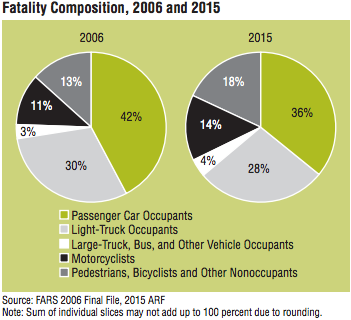 A growing US economy means more trucks on the nation’s highways and roads. Unfortunately, it also means more traffic fatalities involving trucks, according to a new report.
A growing US economy means more trucks on the nation’s highways and roads. Unfortunately, it also means more traffic fatalities involving trucks, according to a new report.
The National Highway Traffic Safety Administration reported that truck-involved crashes resulting in fatalities increased by 4.4 percent in 2015. And at least part of that increase was attributed to more truck drivers driving more miles to make more deliveries.
Biggest Increase Since 2008
The number of fatal accidents involving trucks during 2015, 4,067, was the highest amount since 2008. Perhaps not coincidentally, that was also the beginning of the worldwide global economic slowdown dubbed “The Great Recession”.
By last year, the US economy was generally back on track, resulting in an increase in the amount of truck traffic and the corresponding increase in fatal crashes, according to the NHTSA.
“When the economy has a downturn, fatalities generally decrease,” the report states. “And during times of economic recovery, fatalities tend to increase.”
Inverse Relationship between Unemployment and Traffic Deaths
One of the factors analysts looked at was the relationship between the US unemployment rate and the number of fatal truck accidents.
“The unemployment rate is an overall measure of US economic picture, which could affect the number of fatalities by getting more people on the road as unemployment goes down, both for work-related travel and increased recreational travel,” the report said.
Another likely contributor was the 3.5 increase in vehicle miles traveled by truck drivers. The fatality rate per 100 million vehicle miles traveled rose 3.7 percent — to 1.12 — during 2015, according to the NHTSA.
Other Contributing Factors
Fatal truck crashes related to drivers distracted by texting, surfing the Web, or using their smartphones and other portable devices increased 8.8 percent between 2014 and 2015. Alcohol-impaired fatalities increased 3.2 percent, speeding-related crashes jumped 3 percent, and accidents involving drowsy drivers rose 3.2 percent. Nearly half of all passenger vehicles occupants killed were not wearing seat belts.
The nation as a whole needs to do more to bring these numbers down, according to Dr. Mark Rosekind, administrator for the NHTSA.
“The data tell us that people die when they drive drunk, distracted, or drowsy, or if they are speeding or unbuckled,” Rosekind said in an NHTSA news release announcing the data. “While there have been enormous improvements in many of these areas, we need to find new solutions to end traffic fatalities.”
Truck drivers were least likely to be killed in fatal accidents involving big rigs. Of the 4,047 fatalities in crashes involving trucks, only 16.4 percent were occupants of large trucks, 10.1 percent were nonoccupants, and 73.5 percent were drivers of other vehicles.
Accidents involving trucks weren’t the only class to see an increase in deaths. Pedestrian and pedal cyclist fatalities increased to a level not seen in 20 years and motorcycle deaths rose more than 8 percent, according to the report.
